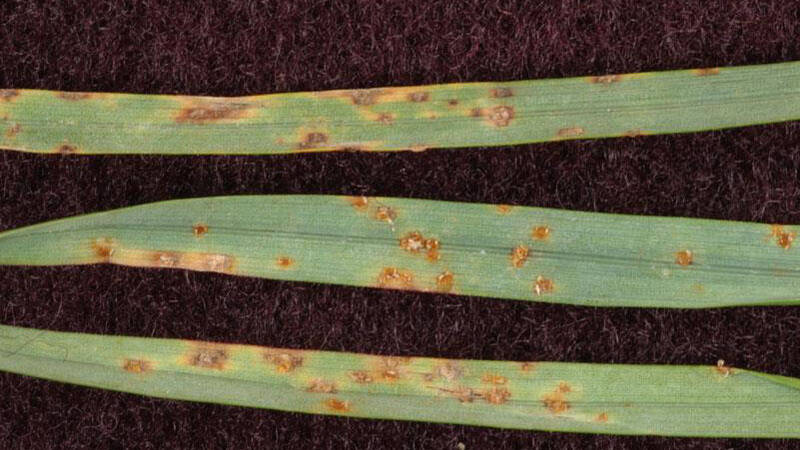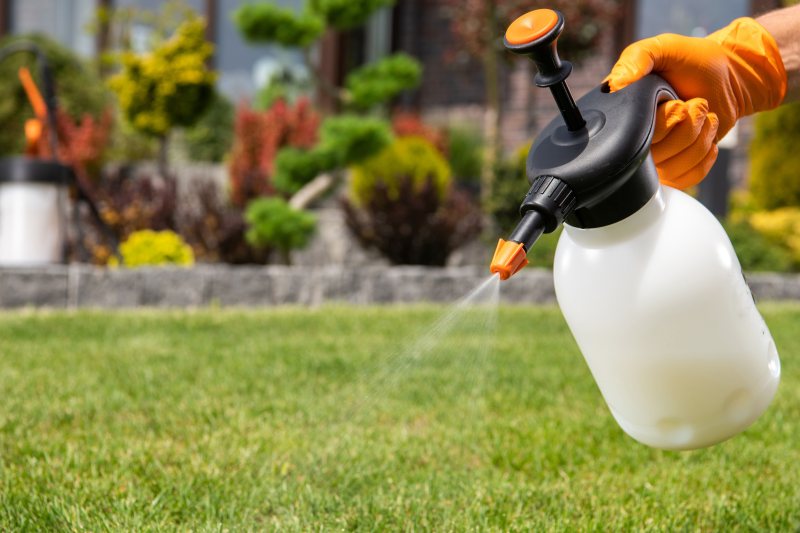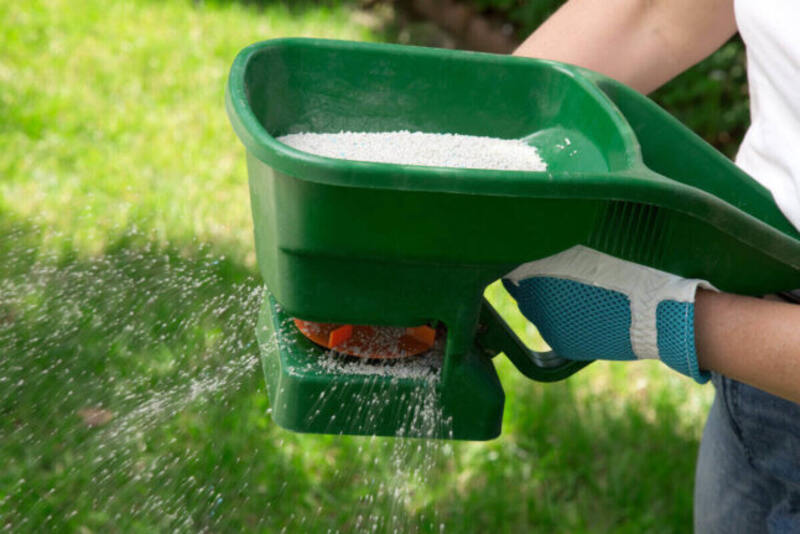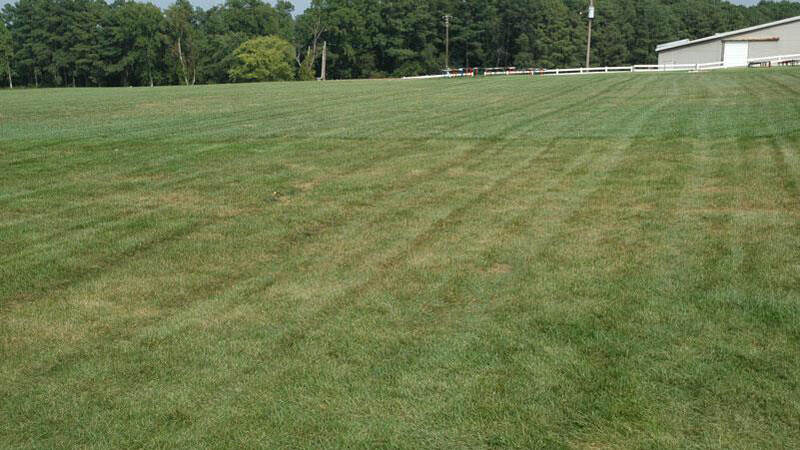
Yellow turf is never a good sign. But if it’s a symptom of leaf rust on your grass, it’s not that bad, either. A foliar disease attacking slow-growing grass in warm and wet weather, leaf rust, aka grass rust, looks worse than it really is and rarely kills the grass.
Still, don’t ignore it; the tiny rusty-orange spores travel like the wind, and the disease can take over the entire lawn in a few years if allowed. Read this guide and learn how to identify, control, and prevent leaf rust in lawns with proper cultural practices and optimum results with few to no fungicides.
How to Recognize Leaf Rust Disease

A colorful fungal disease, leaf rust is easily recognizable if you know what signs to look for. Find out from this section where we talk about:
- Signs and Symptoms of Leaf Rust Disease
- When Does Leaf Rust Attack Lawns?
- How to Test for Leaf Rust
- Lawn Diseases You Can Confuse With Rust
Signs and Symptoms of Leaf Rust Disease
Compared with other common lawn diseases, leaf rust is easy to spot. Its tell-tale sign is a rusty orange powdery mass released from pustules grown on infected grass blades. The powder is nothing but fungi spores. They spread with the wind, get on your fingers if you touch infected plants, or stick to your shoes and clothes if you walk through the lawn. You can’t miss it; no other fungal disease has orange spores like these.
There are also other signs and symptoms to watch for:
- Small yellow flecks on leaf blades. Grass rust starts by forming small yellow, orange, or brick-red dots on individual grass blades. They tend to align parallel to the leaf’s veins when taking over a larger leaf surface. Infection typically starts from the tip.
- Orange to brown pustules. Infected dots slowly grow, turning into tiny orange-to-brown blisters filled with spores called pustules or uredenia. Pustules rupture easily when you touch them, walk through the grass, or the wind blows. They release a rusty orange to brown dust that is spore powder and spreads the disease.
- Weakened grass blades. Infected leaves look thin and weak and break down easily.
- Yellow-green to orange areas. Affected lawns have a yellow-green to orange tint in the infected areas.
- Thinned lawn. You’ll also notice a general thinning in your turf.
When Does Leaf Rust Attack Lawns?
Infection typically occurs during mild and wet weather in late spring to early summer and in fall. According to the New Mexico State University, leaf rust fungi need mild cool to warm temperatures (60 to 86°F) and condensed moisture on grass leaves and stems for 10 to 12 hours to penetrate the tissue and infect the turf.
Disease development starts as soon as the weather gets hotter and drier, usually by mid-summer, and continues throughout the summer and the first weeks of autumn. It’s when the outbreaks occur, and infected lawns take on the sickly, orange look. Rust spores infecting the turf in the fall won’t have the time to develop and multiply. They’ll overwinter in infected plants and return with the spring to pick up where they left off.
How to Test for Leaf Rust
Testing for leaf rust disease DIY is straightforward. Put a white cloth on your hand and brush it through the grass in an area showing signs of infestation. If it’s leaf rust, the cloth will get a thick layer of rust orange powder, the fungi spores.
Since it’s a mild disease, homeowners rarely go so far as to send test samples to a plant pathology lab. Consider this option if you’re dealing with a severe infestation or the grass doesn’t recover as expected.
Lawn Diseases You Can Confuse With Rust
From a distance, the yellowish, thin grass infected by the rust fungi can resemble drought stress and other lawn diseases such as dollar spot, brown patch, and leaf spot. They all create more or less regular patches of turf that look dry and sick, but a few essential differences set them apart.
Dollar Spot and Brown Patch
For example, dollar spot and brown patch disease spread by a whitish, thread-like mycelium visible on the soil and grass on dewy mornings. They don’t spread through spores, so you won’t see the rusty-orange powder specific to the grass rust disease.
Leaf Spot
The leaf spot disease is harder to distinguish from grass rust since it also spreads by reddish-brown spores and causes individual leaf lesions that can be confused with those of leaf rust. Leaf spot lesions are indeed darker in color, with a reddish-brown hue, but even so, a lab test is the only 100% sure method to set these two apart in a lawn.
How to Treat a Leaf Rust Infection

Leaf rust is a fungal disease that can be treated and kept at bay only with cultural practices, but fungicides can also be needed in severe cases. In this section, learn about:
Cultural Practices to Control and Treat Leaf Rust in Your Lawn
Fungicide applications are a last-resort solution for leaf rust disease, only used in severe cases. The best way to control it once active is to use cultural practices such as:
Mow Away Infected Grass Tips
When mowing an infected area, you cut infected leaves’ tips and reduce the spores available for spreading the disease. Bag the infected grass clippings carefully (leave none behind!), and never add them to your compost pile during an infestation. Even with hot composting, you risk putting the spores back in the foliage when using the finished compost.
Avoid mowing wet grass and always cut only up to ⅓ of the blade length to ensure plants have enough energy to fight diseases and pests and develop properly. As for the mowing height, keep the grass at the tallest height recommended for your turf type and the current season.
Prune Back Trees and Shrubs
Let in some more light and fresh air! Prune back trees and shrubs around the lawn to increase the amount of sunlight that reaches the turf. This practice also ensures better air circulation, allows excess moisture to evaporate more easily, and limits fungal infection. If you hire a pro, tree trimming and pruning costs about $315 to $700.
Feed the Grass
Since this is a foliar disease, nitrogen can help the leaves recover faster if applied correctly. Apply a balanced nitrogen fertilizer with potassium and phosphorus to boost grass growth when the first signs of leaf rust appear.
Don’t overdo it! Read the product instructions carefully and consult your local Extension Office agent or a lawn care pro about applying the proper amount of nitrogen during a rust infection.
Check the Sprinkler System
If your lawn shows signs of leaf rust disease, you might have a slow-growing turf due to drought stress. Check this hypothesis and solve the problem fast. Properly watered lawns recover faster.
Do a sprinkler system audit, and ensure all sprinkler heads are working properly and are positioned correctly. Repair or replace broken sprinkler heads and put your lawn on a proper irrigation schedule for the season.
Reduce Moisture Levels
You can’t control the rain, dew, or cloudy weather. But you can do a few things to reduce the moisture levels in your lawn if too high:
- Core aerate. Aeration loosens the soil, improving water absorption and drainage and reducing puddling and moisture retention in the thatch layer and topsoil. If you don’t own an aerator or don’t have the time for DIY aeration, you can hire a lawn care company to aerate the lawn for about $75 to $225.
- Dethatch. Do a gentle dethatching on infected areas to remove part of the organic matter layer covering the soil and smothering the grass. Thatch prevents water evaporation and keeps the moisture level high around grass roots, crowns, stems, and basal leaves.
- Water deeply and less often. Adjust your automatic sprinkler system to water less often and for longer periods to soak the top 4 to 6 inches of soil. Watering deeply encourages roots to grow healthier. Watering less often prevents long-term moisture in the thatch layer and topsoil.
Chemical Control
Correct cultural practices followed diligently are often enough to keep lawn rust from activating on a healthy turf. But, in some cases, the infection is too severe and keeps coming back yearly despite careful lawn maintenance. That’s when it’s time to bring in preventive fungicides.
A preventive fungicide spray program starts with an initial application when lawn rust signs are first detected in the grass and continues with repeated applications 7 to 14 days apart as long as the disease is prevalent in the lawn.
For best results:
- Apply the fungicide after mowing and removing grass clippings.
- Use 2 to 3 gallons of water with fungicide per 1,000 square feet to ensure proper coverage of grass leaves.
- Consider adding a surfactant or spreader-sticker to your fungicide mixture to keep the liquid from running off the grass leaves.
Some of the best lawn fungicides used to prevent and treat leaf rust disease are:
The problems with fungicides are how expensive they are and how difficult they can be to obtain for anyone not in the industry. Of the fungicides recommended for treating leaf rust above, the most affordable is around $70, and the most expensive is more than $400. For this reason, you may actually save money by hiring a pro to treat your lawn for you if the infection is bad enough to warrant fungicides.
How to Repair the Grass After Leaf Rust
Grass rust damages only the foliage of grass plants, and infected tips can be removed gradually by mowing as the grass grows, replacing the rusty orange look with a beautiful green.
You can support turf growth by ensuring proper watering, especially during drought spells, and providing additional nutrients. A short boost with a quick-release nitrogen fertilizer is often recommended to speed up the healing process.
Be careful with the amount, though. You don’t want to force the grass to grow too much, especially if it’s a cool-season turf during summer semi-dormancy.
Expect to get your healthy-looking turf back in 2 to 3 weeks.
How to Prevent Lawn Rust

To prevent leaf rust from returning to your turf, upgrade your lawn care routine and implement proper cultural practices, such as:
- Fertilize Correctly
- Adapt Your Irrigation Schedule to Your Turf’s Needs
- Periodically Schedule Soil Maintenance
- Mow the Grass Properly
- Overseed With Resilient Cultivars
Fertilize Correctly
Use slow-release fertilizer to fertilize during the growing season when the grass is actively developing and using nutrients. This means late spring and early summer for warm-season grasses like Bermuda, Zoysia, and St. Augustine.
Fertilize in early spring and late summer to early fall for cool-season grasses like perennial ryegrass, tall fescue, and fine fescues.
Avoid quick-release fertilizers, nitrate formulas, and applying nitrogen too early or too late in the year when the grass is still dormant or preparing for dormancy. Excess nitrogen during these periods forces the grass to grow faster, less resilient, and with weaker root systems. At the same time, nitrogen deficiency during the growing season makes the grass grow slower, exposing it to grass rust.
Test the soil periodically to identify and treat deficiencies and prevent excess fertilization by always adding what nutrients your soil needs.
Talk to your local Extension Office agent or a lawn care professional to set up a proper fertilization schedule for your type of turf and local climate. It’s the surest method to fertilize like a pro and enjoy a healthy lawn year-round.
Adapt Your Irrigation Schedule to Your Turf’s Needs
The best way to grow healthy, resilient turf is to water as needed by observing when the grass shows signs of stress. Apply about 1 inch of water weekly and aim to moisten the soil 4 to 8 inches deep. Deep watering trains the turf to grow deeper roots, making it more drought-resistant.
Irrigate early in the morning during hot summer days to avoid evaporation and ensure enough water percolates the soil at the root level. Experts say between 2 and 6 a.m. is the best time to water the lawn during high heat spells. Unless you plan to convert into a night owl during summer, install a sprinkler timer to help you automate the irrigation process.
Here are a few models of sprinkler timers that are popular this year:
- Rain Bird 6-Station Indoor Simple-To-Set Irrigation Timer
- Prociv Sprinkler Timer 2 Zone
- Rachio 16-Station Wi-Fi Compatible Smart Irrigation Timer
Don’t water your lawn in the late evening, and avoid nighttime watering, since the grass won’t have a chance to dry without the sun. Droplets on the leaves for more than 8 to 10 hours are a sure recipe for fungal foliar diseases like rust, dollar spot, leaf spot, and brown patch.
Periodically Schedule Soil Maintenance
Aerate and dethatch at least once a year to keep the soil loose, with good drainage and a friendly structure for root development.
Add topdressing to your lawn’s soil in the spring for warm-season grasses and in the fall for cool-season grasses. Topdressing enriches the soil with nutrients, organic matter, and beneficial organisms, promoting healthy turf growth. It also helps improve topsoil structure.
Mow the Grass Properly
Avoid mowing the lawn lower than the recommended height. Taller blades promote deeper roots and have a larger surface area for photosynthesis, producing precious energy for the turf to thrive and fight diseases.
Only mow the grass when the blades are not wet, and keep the lawn mower blades sharp to ensure a clean cut that heals fast.
Also, remember the golden rule of thirds – only cut up to ⅓ of the turf height each mowing session to ensure it recovers fast.
We have a detailed guide about lawn mowing that you can read to get up to speed with the most important rules for a healthy lawn. If you don’t have the time to mow as often as you should, consider hiring a lawn care service. It costs $30 and $65 to have your lawn professionally mowed – it’s one task less for you to do, and the grass will always look fantastic.
Overseed With Resilient Cultivars
A good strategy to keep rust disease at bay is to seed the lawn with turf mixes instead of one single species. Also, check with your local Extension Office and nurseries for turf cultivars resilient to lawn rust that are available in your area.
A few examples of disease-resistant turfgrass cultivars are:
- Kentucky bluegrass cultivars: Adelphi, Argyle, Bonnieblue, Brunswick, Challenger, Enmundi, Fylking, Majestic, Nassau, Nugget, Parade, Rugby, Victa, Wabash, and Welcome
- Fine fescue cultivars: Ensylva, Flyer, and Shadow
- Perennial ryegrass cultivars: All-Star, Blazer, Cowboy, Delray, Fiesta, Gator, Loretta, Manhattan II, Omega II, Palmer, Premier, Tara, and Yorktown.
- Zoysiagrass cultivar: Belair
- Tall fescue cultivars: Adventure, Falcon, Mustang, and Olympic
- Bermudagrass cultivar: Common Bermudagrass
Shaded areas are most vulnerable to leaf rust. If you have them on your lawn, prune the trees and shrubs to bring back sunlight and improve airflow. Also, choose turf with good shade tolerance, like red fescue, velvet bentgrass, St. Augustinegrass, or Manila grass.
What Causes Leaf Rust Disease in Lawns?

Grass rust is a foliar disease that affects turf and cereals. It creates disturbing rusty orange patches but rarely causes severe damage, and infected grass recovers in 2 to 3 weeks.
Several pathogens cause the grass rust disease. They manifest similar symptoms but focus on damaging different plant parts. Among these nasty grass dwellers, the most common turf rust fungi you’ll meet in your lawn are:
- Puccinia graminis causing stem rust.
- Puccinia coronata causing grass crown rust.
- Puccinia striiformis causing stripe rust.
- Uromyces spp. causing leaf rust.
Grass rust fungi survive winter as mycelium in living plants and as thick-walled teliospores in thatch and soil. If left untreated, they return and attack the lawn again when favorable environmental conditions occur.
Susceptible Turfgrasses
Grass rust attacks warm-season and cool-season grasses equally. The most susceptible grasses are:
- Perennial ryegrass
- Tall fescue
- Fine fescues
- Kentucky bluegrass
- Bermudagrass
- St. Augustinegrass
- Zoysiagrass
The most vulnerable grasses are the slow-growing ones, exposed to stress by weather conditions or faulty lawn care practices. Low fertility, low light, and low water are three main factors that can set your turf up for failure when keeping leaf rust at bay.
Factors Favoring Leaf Rust on Grass
Like most other foliar diseases, leaf rust is also favored by prolonged leaf wetness and stressed, slow-growing turf that hasn’t been fed or managed properly. Here’s a list of the main factors that can welcome leaf rust in your turf.
- Low light. Whether caused by cloudy weather, trees, shrubs, or buildings around the lawn, low light limits grass growth and water evaporation, increasing the risk of fungal infection. Leaf rust infection often appears first in shaded or protected lawn zones and later in sunlit areas.
- Leaf wetness. Periods with heavy rainfall, high dew points, and overwatering or light watering daily expose the grass to prolonged leaf wetness. Condensed moisture on grass blades is a critical condition fungi need to infect the plants and develop.
- Poor airflow. Dense tree foliage surrounding a lawn blocks airflow, keeping moisture inside and grass wet for longer periods.
- Soil compaction. Compacted soil has poor water drainage and is predisposed to puddling and runoff, often keeping moisture in the topsoil and thatch layer for a long time. It also prevents the development of deep, strong roots and limits access to oxygen.
- Thick thatch. A thatch layer over ½-inch thick keeps moisture from evaporating, makes a humid layer near grass stems and leaves, and offers shelter for fungi. It can also lead to grass roots developing in the thatch layer instead of going deep into the soil.
- Nitrogen deficiency. Poor fertility leads to slow growth and weak plants that are easier for grass rust fungi to infect and damage.
- Underwatering. Drought spells, a faulty sprinkler system, or water restrictions can make the grass more vulnerable to infection, slowing its growth.
FAQ About Leaf Rust Disease in Grass
What Does Rust Fungus Look Like on Grass?
The rust fungus makes grass take a yellow to orange tint, similar to drought stress. From up close, leaves have orange, brick-red to brown spots that grow into pustules and later break, spreading a rusty powder of spores and infecting healthy areas.
Is Lawn Rust Harmful?
Lawn rust is generally a mild disease that attacks only the foliage and doesn’t kill the grass. Turf typically recovers in 2 to 3 weeks, but in severe infections, the disease can return yearly to larger areas. Lawn rust fungus is not harmful to pets or humans.
Will Lawn Rust Go Away on its Own?
In properly maintained lawns with correct fertilizer applications, watering, mowing, and soil management, lawn rust can go away on its own without using fungicides.
Does Fertilizer Help with Lawn Rust?
Yes, grass rust mainly infects poorly fed, slow-growing lawns, so a balanced fertilizer can help limit the disease.
When to Call the Pros
Call a lawn care pro if you’re unsure whether it’s leaf rust you’re seeing on your lawn or if you’ve been fighting off leaf rust infections for several years, and nothing you do seems to discourage the nasty fungi. LawnStarter can connect you with the best lawn care experts in your area so you won’t waste time looking all over the internet. Book a vetted lawn treatment company now and say goodbye to grass rust and hello to grass health and impeccable green.
Main Photo Credit: NC State Cooperative Extension